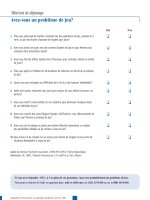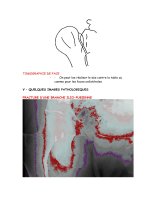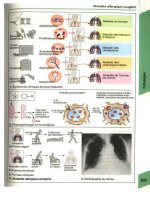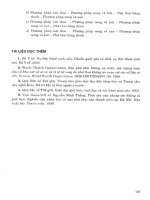Applied Surgical Physiology Vivas - part 8 pot
Bạn đang xem bản rút gọn của tài liệu. Xem và tải ngay bản đầy đủ của tài liệu tại đây (288.78 KB, 19 trang )
PROXIMAL TUBULE AND LOOP OF
HENLE
1. What is the principle function of the proximal
convoluted tubule (PCT)?
This structure is the kidney’s major site for reabsorption
of solutes – in fact, 70% of filtered solutes are reab-
sorbed at the PCT.
2. What kinds of solute?
The most important are sodium, chloride and potas-
sium ions. In addition, nearly all of the glucose a
nd
amino acids filtered by the glomerulus are reabsorbed
here.
The first half of the PCT also absorbs phosphate and
lactate.
3. Which membrane pump system is key to the PCT
reabsorptive abilities?
The Na
ϩ
-K
ϩ
ATPase pump.
4. What are the basic functions of the loop of Henle?
᭹
Solute reabsorption: about 20% of filtered sodium,
chloride and potassium ions are absorbed in the
thick ascending limb of Henle
᭹
Water reabsorption: about 20% of filtered water is
absorbed at the thin descending limb of Henle
᭹
Formation of the counter current multiplication system:
this is an efficient way of concentrating the urine
over a relatively short distance along the nephron
with minimal energy expenditure
5. Why there is no water reabsorption at the ascending
limb of Henle?
This portion of the loop of Henle is impermeable to
water.
APPLIED SURGICAL PHYSIOLOGY VIVAS
P
PROXIMAL TUBULE AND LOOP OF HENLE
᭢
121
P
PROXIMAL TUBULE AND LOOP OF HENLE
APPLIED SURGICAL PHYSIOLOGY VIVAS
᭢
122
6. What is the basic function of the DCT and
collecting duct?
᭹
Reabsorption of solute: about 12% of filtered sodium
and potassium are absorbed here
᭹
Secretion: variable amounts of potassium and protons
are secreted here
᭹
Reabsorption of water: this occurs only at the most
distal portions of the DCT and collecting duct,
since the more proximal areas are impermeable to
water
7. What is one of the most important factors regulating
the reabsorption of solutes and water across the PC
T
and loop of Henle?
The Starling forces (see Microcirculation I).
8. Which hormone plays a central role in the control
of water excretion?
ADH (also known as arginine vasopressin).
9. Where is this hormone produced?
In the posterior pituitary gland.
10. How does t
he body monitor changes in the plasma
osmolality?
By the activity of osmoreceptors located in the hypo-
thalamus.
11. Thus, what are the two most important factors in
controlling the release of ADH?
᭹
Increased plasma osmolality: water loss leads to an
increase in the plasma [Na
ϩ
], which increases the
plasma osmolality
᭹
Decrease in the effective circulating volume: this triggers
activity in vascular baroreceptors
APPLIED SURGICAL PHYSIOLOGY VIVAS
P
PROXIMAL TUBULE AND LOOP OF HENLE
᭢
123
12. Once released, what is the effect of ADH on the
kidney?
This leads to an increase in the reabsorption of solute-
free water by the collecting duct.
Also leads to NaCl reabsorption by the thick ascending
limb of Henle. By increasing the concentration of the
interstitium around the loop of Henle, this enha
nces
the nephron’s ability to reabsorb water.
13. Draw a simplified diagram of the loop of Henle
when ADH secretion is maximal during a period of
dehydration. What is happening?
Decreased effective circulating volume
↑ Sympathetic activity
↑ Renin
↑ Angiotensin I
↑ Angiotensin II
↑ ADH
Brain
↑ Aldosterone
Adrenal
gland
Lung
Heart
↓ ANP
↓
Na
ϩ
, H
2
O
excretion
From Koeppen BE, Stanton BA. Renal Physiology, 1992, London,
with permission from Elsevier
1. Fluid enters the descending limb of Henle that is
isotonic with the plasma. The tubular fluid that
leaves the PCT is always isotonic with the plasma
P
PROXIMAL TUBULE AND LOOP OF HENLE
2. The descending limb of Henle is permeable to
water (and only slightly permeable to salt and urea.
Therefore, water is progressively absorbed down
the limb, becoming more and more concentrated
(up to 1,200 mOsmol
Ϫ1
)
3. The ascending limb of Henle is impermeable to
water, but permeable to sodium chloride. There is
passive diffusion of NaCl down its concentration
gradient, when travelling up the limb. This dilutes
the tubular fluid
4. When the thick ascending limb is reached, NaCl is
actively pumped out, further diluting the tubular
fluid. ADH increase
s the pumping of NaCl into the
interstitium
5. By the time that the tubular fluid reaches the
collecting duct, it is hypotonic compared to the
interstitium. Therefore, in the presence of ADH
(which increases the water-permeability of the
collecting duct), water is rapidly reabsorbed
6. By the time that urine is excreted, it has a very
high osmolality (up to 1,200 mOsmol
Ϫ1
)
APPLIED SURGICAL PHYSIOLOGY VIVAS
124
APPLIED SURGICAL PHYSIOLOGY VIVAS
P
PULMONARY BLOOD FLOW
᭢
125
PULMONARY BLOOD FLOW
1. If the normal CO at rest is said to be 5–6 Lmin
؊1
,
what is the output of the right side of the heart?
This is also 5–6Lmin
Ϫ1
since under normal circum-
stances; the outputs of both sides of the heart are the
same.
2. Give a normal value for the pulmonary artery
pressure (PAP).
3. Why is this so much lower than the systemic arterial
pressure?
The principle reason is that the pulmonary vascular
resistan
ce is only about one tenth of the systemic vascular
resistance.
4. Define the PVR. Give the normal range.
This is defined by the equation:
where PAP ϭ mean PA pressure; CVP ϭ central venous
pressure; CO ϭ cardiac output
The normal range is 150–250 dynes-sec/cm
5
. Note that
if not multiplying by 80, then the calculated figure for
the resistance is given in Wood units.
5. Below is a graph showing the relationship of the
PVR to increasing pulmonary arterial and venous
PVR
PAP CVP
CO
ϭ
Ϫ
ϫ80
25
8
mmHg.
P
PULMONARY BLOOD FLOW
APPLIED SURGICAL PHYSIOLOGY VIVAS
᭢
126
pressures. Briefly, what does this show, and why does
this occur?
10
0
100
200
300
20
Increasing
venous pressure
Increasing
arterial pressure
Arterial or venous pressure
(cmH
2
O)
From West JB. Respiratory Physiology: The Essentials, 1989,
Lippincott, Williams & Wilkins
Pulmonary vascular resistance
(cmH
2
O/l/min)
30 40
᭹
This shows that the PVR falls with rising pulmonary
and venous pressures
᭹
This occurs because of distension of the thin-walled
pulmonary vessels when engorged with blood
following a pressure rise. This distension leads to an
overall fall in the PVR. Also, the recruitment of
previously empty pulmonary vessels adds further to
a fall in the PVR. The concepts of pulmonary
vascular distension and recruitment can be
pictorially seen below, the effects of both being to
drop the PVR
APPLIED SURGICAL PHYSIOLOGY VIVAS
P
PULMONARY BLOOD FLOW
᭢
127
6. Below is a graph showing the relationship between
the PVR and the lung volume at constant intra-alveolar
pressure. Again, what does this show, and what is the
explanation?
Distention
Recruitment
From NMS: Physiology, 4th edition, Bullock, Boyle & Wang, 2001,
Lippincott, Williams & Wilkins
Increased pulmonary blood flow can lead either to
distension of pulmonary vessels, or to recruitment of collapsed vessels
20015010050
120
100
80
60
Vascular resistance
(cmH
2
O/l/min)
Lung volume (ml)
From West JB. Respiratory Physiology: The Essentials, 1989,
Lippincott, Williams & Wilkins
P
PULMONARY BLOOD FLOW
APPLIED SURGICAL PHYSIOLOGY VIVAS
᭢
128
᭹
This shows that at very low lung volumes, the PVR is
relatively high, but soon falls following distension of
the lungs. After this initial fall, with increasing
volumes, the PVR rises again. This rise in the PVR
following the initial dip is virtually exponential
᭹
Much of these changes can be explained in terms of
the elastic forces generated by the collagen and
elastin of the lung parenchyma (see ‘Mechanics of
breathing IV’). At increasing lung volumes, the elastic
recoil forces of the lung increase. This produces a
circumferential radial traction force that pulls small
airways (i.e. those without cartilaginous walls) and
blood vessels open; thus reducing their resistance to
the flow of air a
nd blood respectively
᭹
At very small lung volumes, due to little radial
traction, pulmonary vessels are collapsed. This has
the effect of increasing the overall PVR
᭹
As the lung expands, radial traction forces on the
blood vessels increase, increasing their calibre. This
causes a progressive fall in the PVR
᭹
At increasing volumes, radial traction overstretches the
pulmonary vessels, reducing their calibre. Thus,
once again, the PVR rises, and blood flow falls
7. Taking the above into account, summarise the
factors controlling the PVR, and hence the pulmonary
blood flow.
᭹
Pulmonary arterial and venous pressure
᭹
Lung volume
᭹
Pulmonary vascular smooth muscle tone: this is affected
by various mediators, such as the catacholamines,
histamine, 5-HT, and arachidonic acid metabolites
᭹
Hypoxia: this also has an effect on the smooth
muscle tone, but is listed separately due to its
importance. This leads to pulmonary
vasoconstriction, with an increase in the PVR. The
result of this is to improve the ventilation-perfusion
ratio in the lung in the face of a fall in the PaO
2
.
It can therefore be considered to be a defence
mechanism against the deleterious effects of
hypoxia, e.g. in situations of COPD. However,
chronic hypoxia, can lead to irreversible pulmonary
hypertension with progressive right heart failure
(cor pulmonale). (See also ‘Ventilation-perfusion
relationships in the lung’.)
8. Nitric oxi
de (NO) is the main method by which
many of these mediators act. It is also often used in
the management of pulmonary hypertension in the
critically ill. What is its mode of action?
᭹
It has a very short duration of action, and functions
through stimulation of intracellular Guanylate
cyclase, which produces cGMP from GTP. This in
turn stimulates cGMP-dependant protein kinases
that are involved in causing vessel wall smooth
muscle cell relaxation
᭹
Bradykinin and 5-HT are examples of mediators
that act through NO
9. Under normal circumstances, how is the blood flow
in the lungs distributed?
᭹
In the standing position, the lowest parts of the
lungs receive the greatest blood flow. In fact, a
linear decrease in the blood flow distribution can be
seen from apex to base
᭹
This is because the hydrostatic pressure of the most
dependent portions is greater
10. How does this alter with exercise?
During mild exercise, the blood flow to the upper and
lower portions of the lung increases, but the overall dis-
tribution of the flow is more even than during rest.
APPLIED SURGICAL PHYSIOLOGY VIVAS
P
PULMONARY BLOOD FLOW
129
R
RENAL BLOOD FLOW
APPLIED SURGICAL PHYSIOLOGY VIVAS
᭢
130
RENAL BLOOD FLOW (RBF)
1. What percentage of the CO do the kidneys receive?
20–25%, so that the RBF is 1.0–1.2Lmin
Ϫ1
.
2. Below is a graph showing the variation of the RBF
with the ar terial pressure. What does this show?
200
150
100
50
0
2.0
1.5
1.0
0.5
0
40 80 120
Mean arterial blood pressure (mmHg)
From Lecture Notes on Human Physiology, 3rd edition, Bray, Cragg,
Macknight, Mills & Taylor, 1994, Oxford, Blackwell Science
RBF
GFR
GFR (ml min
Ϫ1
)
RBF (L min
Ϫ
1
)
160 220 240
This graph shows that the RBF, like many specialised vas-
cular beds, is controlled largely by autoregulation. Thus,
between mean arterial pressures of 80–180 mmHg, RBF
is fairly constant, at about 1.2Lmin
Ϫ1
.
3. How is this achieved?
There are two main theories to explain how renal
autoregulation of blood flow occurs:
᭹
Myogenic mechanism: an increase in renal vascular
wall tension that occurs following a sudden rise in
arterial pressure stimulates mural smooth muscle
cells to contract, causing vasoconstriction. This
reduces the RBF in the face of rising arterial
pressures. Most of this myogenic response occurs in
the afferent arteriole
APPLIED SURGICAL PHYSIOLOGY VIVAS
R
RENAL BLOOD FLOW
᭢
131
᭹
Tubuloglomerular feedback: alterations in the flow of
blood that occurs with alterations in the arterial
pressure leads to stimulation of the juxtaglomerular
apparatus. This leads to a poorly defined feedback
loop that results in changes of the RBF to the
baseline level
4. Name some other factors that are important for the
control of RBF.
᭹
SNS: this controls the tone of the afferent and
efferent arteriole. By stimulation of ␣
1
-
adrenoceptors there is vasoconstriction and
reduction of blood flow
᭹
Angiotensin II: as part of the control by the renin-
angiotensin-aldosterone system. This hormone
stimulates vasoconstriction, leading to a reduction
of the RBF and GFR
᭹
Local mediators: such as PGE
2
and PGI
2
, both of
which cause arteriolar vasoconstriction
5. Which agent has traditionally been used to measure
the RBF?
The organic acid, para-aminohippuric acid (PAH).
6. Which physiologic properties make it ideal for the
measurement of the RBF?
PAH in the circulation is completely elimin
ated
through the processes of filtration and secretion by the
tubules, so that there is none found in the renal vein
following passage through the kidneys. Therefore, in
effect, the rate of clearance of PAH from the circulation
in equal to the renal plasma flow (RPF). This can be
seen below:
RPF
UV
P
PAH
PAH
ϭ
и
R
RENAL BLOOD FLOW
APPLIED SURGICAL PHYSIOLOGY VIVAS
132
where U
PAH
ϭ Urine PAH concentration; P
PAH
ϭ Plasma
PAH concentration.
7. How can the RBF be calculated from the RPF?
where RPF ϭ renal plasma flow; HCT ϭ haematocrit.
RBF
RBF
HCT
ϭ
Ϫ1
APPLIED SURGICAL PHYSIOLOGY VIVAS
R
RESPIRATORY FUNCTION TESTS
᭢
133
RESPIRATORY FUNCTION TESTS
1. Draw a typical spirometry tracing, and label the
various volumes that the waveforms represent.
Time
From NMS: Physiology, 4th edition. Bullock, Boyle & Wang, 2001,
Lippincott, Williams & Wilkins
Volume
RV
ERV
IRV
FRC
IC
VC
TLC
VT
Spirogram
2. Which of the volumes and capacities may be
measured directly?
Note that the ‘capacities’ are derived by adding
‘volumes’ together. The following can be measured
directly:
᭹
Tidal volume (TV)
᭹
Inspiratory reserve volume (IRV)
᭹
Expiratory reserve volume (ERV)
᭹
Inspiratory capacity (IC) ϭ (TV ϩ IRV)
᭹
Vital capacity (VC) ϭ (IRV ϩ TV ϩ ERV)
3. Then, which must be calculated by other sources?
᭹
Residual volume (RV)
R
RESPIRATORY FUNCTION TESTS
APPLIED SURGICAL PHYSIOLOGY VIVAS
᭢
134
᭹
FRC ϭ (RV ϩ ERV)
᭹
Total lung volume (TLV) ϭ (VC ϩ RV)
4. Give some typical values for the TV, IRV and ERV.
᭹
TV: 500 ml, or 7mlkg
Ϫ1
᭹
IRV: defined as the volume that can be inspired
above the TV. Typically 3.0L
᭹
ERV: the volume of gas that can be expired after a
quiet expiration. Typically 1.3L
5. Define RV.
This is the volume that remains in the lung following
maximal expiration, and may only be measured using
the same method as the FRC (see below). The normal
value is around 1.2–1.5L.
6. Define FRC. Ho
w may it be measured?
This is defined as the sum of the RV and the ERV. It
represents the volume of gas left in the lung at the end
of a quiet expiration.
There are three main methods for its measurement:
᭹
Gas dilution method: using helium placed within the
spirometer. The subject breathes through the system
starting at the end of a quiet expiration. Helium is
not absorbed by the blood but distributed
throughout the lungs. The concentration of helium
expired at the end of equilibration can be used to
calculate the FRC
Total amount of helium ϭ Volume of gas in
spirometer ϫ initial concentration of helium ϭ
Helium concentration at equilibration ϫ (volume
of spirometer ϩ FRC)
᭹
Nitrogen washout: subject breathes pure oxygen from
the end point of a quiet expiration. By analysing the
changes in the concentration of nitrogen, the FRC
may be calculated
APPLIED SURGICAL PHYSIOLOGY VIVAS
R
RESPIRATORY FUNCTION TESTS
᭢
133
RESPIRATORY FUNCTION TESTS
1. Draw a typical spirometry tracing, and label the
various volumes that the waveforms represent.
Time
From NMS: Physiology, 4th edition. Bullock, Boyle & Wang, 2001,
Lippincott, Williams & Wilkins
Volume
RV
ERV
IRV
FRC
IC
VC
TLC
VT
Spirogram
2. Which of the volumes and capacities may be
measured directly?
Note that the ‘capacities’ are derived by adding
‘volumes’ together. The following can be measured
directly:
᭹
Tidal volume (TV)
᭹
Inspiratory reserve volume (IRV)
᭹
Expiratory reserve volume (ERV)
᭹
Inspiratory capacity (IC) ϭ (TV ϩ IRV)
᭹
Vital capacity (VC) ϭ (IRV ϩ TV ϩ ERV)
3. Then, which must be calculated by other sources?
᭹
Residual volume (RV)
R
RESPIRATORY FUNCTION TESTS
APPLIED SURGICAL PHYSIOLOGY VIVAS
᭢
134
᭹
FRC ϭ (RV ϩ ERV)
᭹
Total lung volume (TLV) ϭ (VC ϩ RV)
4. Give some typical values for the TV, IRV and ERV.
᭹
TV: 500 ml, or 7mlkg
Ϫ1
᭹
IRV: defined as the volume that can be inspired
above the TV. Typically 3.0L
᭹
ERV: the volume of gas that can be expired after a
quiet expiration. Typically 1.3L
5. Define RV.
This is the volume that remains in the lung following
maximal expiration, and may only be measured using
the same method as the FRC (see below). The normal
value is around 1.2–1.5L.
6. Define FRC. Ho
w may it be measured?
This is defined as the sum of the RV and the ERV. It
represents the volume of gas left in the lung at the end
of a quiet expiration.
There are three main methods for its measurement:
᭹
Gas dilution method: using helium placed within the
spirometer. The subject breathes through the system
starting at the end of a quiet expiration. Helium is
not absorbed by the blood but distributed
throughout the lungs. The concentration of helium
expired at the end of equilibration can be used to
calculate the FRC
Total amount of helium ϭ Volume of gas in
spirometer ϫ initial concentration of helium ϭ
Helium concentration at equilibration ϫ (volume
of spirometer ϩ FRC)
᭹
Nitrogen washout: subject breathes pure oxygen from
the end point of a quiet expiration. By analysing the
changes in the concentration of nitrogen, the FRC
may be calculated
APPLIED SURGICAL PHYSIOLOGY VIVAS
R
RESPIRATORY FUNCTION TESTS
᭢
135
᭹
Plethysmography: uses an airtight chamber to measure
the total volume of gas in the lungs
7. What is the normal range for the FRC? What
factors may cause it to increase or decrease?
The normal range is 2.5–3.0L.
It may be decreased by:
᭹
Supine position
᭹
Any restrictive lung disease
᭹
Pregnancy
᭹
Following abdominal surgery
᭹
Following anaesthesia
It may be increased by continuous positive airway pres-
sure (CPAP) and gaseous retention of obstructive lung
diseases.
8. What is the ‘effective’ TV?
This is defined as the TVϪanatomic dead space, and
represents the volume of inspired air that reaches the
alveoli.
9. What is the definition of ‘dead space’?
This is the volume of inspired air that is not involved in
gas ex
change.
10. What types of dead space volume do you know?
There are three types of dead space:
᭹
Anatomic dead space: formed by the gas conduction
parts of the airway that are not involved in gas
exchange, such as the mouth, nasal cavity, pharynx,
trachea and upper bronchial airways. Measured
using Fowler’s method
᭹
Alveolar dead space: composed of those alveoli that
are being ventilated but not perfused. They are
therefore, in effect, not contributing to gas
exchange
R
RESPIRATORY FUNCTION TESTS
᭹
Physiologic dead space: this is the sum of the two
volumes above. The normal value is 2–3mlkg
Ϫ1
measured using Bohr’s method
APPLIED SURGICAL PHYSIOLOGY VIVAS
136
APPLIED SURGICAL PHYSIOLOGY VIVAS
S
SMALL INTESTINE
᭢
137
SMALL INTESTINE
1. What is the main function of the small intestine?
This is the principle site for the absorption of carbohy-
drate, lipid, proteins, water, electrolytes, vitamins and
essential minerals.
2. What is the transit time for chyme to pass through
the small bowel?
2–4
h.
3. What are the three main types of small bowel
motion seen after a meal?
᭹
Peristalsis: in common with the rest of the gut
᭹
Segmentation: more frequent than the above,
occurring about 8 times per minute in the ileum,
lasting for several seconds. Involves localised
contraction of 1–2 cm of bowel that leads to the
propulsion of chyme in both directions. Important
for mixing chyme with the digestive juices
᭹
Pendular movements: longitudinal muscle
contractions lead to movement of the bowel wall
over luminal contents. Also important for mixing
4. How does the motility differ when the small bowel
is empty of contents?
During fasting, a migra
ting motor complex spreads from
the duodenum to the ileocaecal junction. This contract-
ile wave helps to clear the small bowel of any remaining
contents.
5. What is the composition of small bowel secretions?
This is made up of mucous, water and NaCl, predom-
inantly.
6. What is the output of this daily?
1,500 mL per day.









